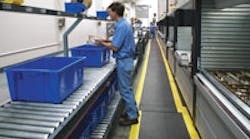Mazak’s 500,000-sq.ft. Florence, Ky., facility produces more than 30 metalworking machine models at the rate of 130 machines a month. Its 45,000-sq.ft. parts center maintains an inventory worth more than $65 million. Ball screws, linear guides, motors, spindles and more, the warehouse stocks parts for every Mazak CNC sold in the Western Hemisphere.
“Mazak made a very strong investment into its aftermarket services because we recognize that our equipment is running in many manufacturing facilities on a 24/7 basis,” says Steve Trammel, national parts manager, Mazak (www.mazak.com). “With lean manufacturing and multitasking so prevalent, it’s extremely important that parts be available immediately to support our customers.”
Lights on the vertical lift modules direct the picker to the parts and indicate the correct tote for the order.
Until recently, Mazak’s stockroom consisted of pallet racks and small vertical lift modules (VLMs) that were operated manually. The orders printed out in the stockroom, and workers used forklifts, skyjacks, ladders and manual VLMs to pick parts and carry them to be packed and shipped.
“Nobody orders parts at 8:00 a.m.,” continues Trammel. “Part orders come in the afternoon and then we have to get them out the same day for delivery to our customers. That was becoming a huge challenge for us in how our stockroom was operating. We have to push through 1,000 to 1,200 orders in pretty much a six-hour window, and we were increasingly throwing more and more manpower into it to deal with the situation.”
Mazak decided to improve the parts center and sought a company that could handle it as a turnkey project. “We were dealing with conveyors, stacker cranes, software and VLMs,” explains Trammel. “We also needed a company that supported their products the way we support our products and that would be there into the future. That is why we selected Remstar.”
|
View more What Works on PlantServices.com |
The upgrade included newer technology and faster equipment, running in an automated environment. “The key was understanding what they were after and how to deliver that — integrating the Shuttle VLMs with software, conveyors, stacker cranes and pick-to-light,” says George Fiorentino, project manager, Remstar (www.remstar.com). “The strength that Remstar offered was our system knowledge and capabilities that we brought to the project, not just our hardware.”
Now, when a customer calls in an order, it’s immediately entered into Mazak’s network system, which tracks the status of each order as it moves through fulfillment (such as what items have been picked and exactly where the order is in the system). Software from FastPic Systems acts as a transaction processor, controlling the operation of Remstar Shuttle VLMs, supplying operator instruction and printing barcode labels.
[pullquote]Each order is assigned to a tote with a fixed license plate, which is placed on a conveyor in the front end of the system. The tote is then routed to one of four pick workstations, each fed by the mainline conveyor with accumulation capability.
When a tote arrives at a workstation, the operator scans it and then scans a light on the station position to associate the tote with the corresponding batch station. The operator can scan as many as eight totes in a workstation, so that eight orders can be picked simultaneously.
When the operator indicates, the Shuttle VLMs move to deliver parts, and a customer-specified barcode part label is printed. Lights on the VLMs direct the operator to the location and indicate how many pieces to pick. The operator then picks them, attaches the barcode label and turns around to place it into the correct tote or order as directed by the lights on the batch station. The operator then picks the next part the VLM presents . This is repeated until the order has the parts required from that warehouse zone.
When an order is complete, the lights direct the operator to push the tote back onto the conveyor, where it either gets routed to one of three pack lanes or goes into another workstation for further fulfillment.
At the pack stations, sensors on the conveyors route the tote to the least full lane. Shipping information is forwarded to the pack area automatically, as well as to overnight shipping carriers to speed package pick up and delivery.
“We saved significant labor,” explains Trammel. “Previously, we were using nine workers to handle 111 orders per worker, per day. It was all we could do to get our orders out.”
The new system is run with five workers, each handling 200 orders per day. Orders picked per person, per hour, has increased by 80%, from 13.9 to 25.
“The Remstar system helped us increase our same-day shipping percentage, too,” says Trammel. “Prior to this system, we were in the 95-plus percent range of shipping same day on our orders. Now we are up to 97.5%. Same-day shipping is no longer an issue. That has been a big improvement.”
